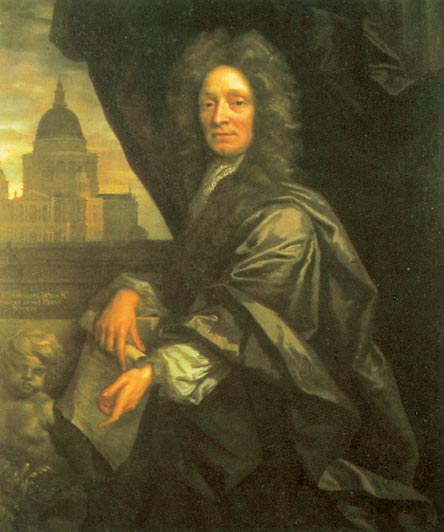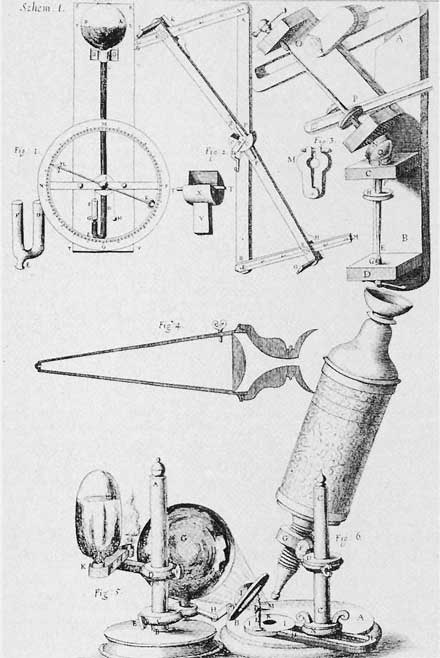
This Article From Issue
September-October 2003
Volume 91, Number 5
DOI: 10.1511/2003.32.0
On a Grander Scale: The Outstanding Life of Sir Christopher Wren. Lisa Jardine. xviii + 600 pp. HarperCollins Publishers, 2002. $34.95.
The Man Who Knew Too Much: The Strange and Inventive Life of Robert Hooke 1635–1703. Stephen Inwood. xxx + 497 pp. Macmillan, 2002. $37.50.
For nearly 50 years the lives and careers of Christopher Wren and Robert Hooke were virtually inseparable. Born in 1632 and 1635, respectively, both were sons of Anglican (and royalist) clergymen—although Wren's father enjoyed the more elevated position. Owing to frail health, each was educated at home before proceeding to Westminster College and then to Oxford, where during the mid-1650s they cemented a lifelong friendship. Wren and Hooke became the most versatile scientific practitioners of the early modern period. Their interests encompassed nearly every branch of the mathematical, physical and life sciences, and they were veritable experts in just about every subject they cared to study. Individually and jointly—it is often impossible to distribute credit between them—they contributed important discoveries and observations to astronomy, mechanics, optics, anatomy, microscopy, geology and chemistry, to name but a few of the areas they enriched. And then, of course, there was architecture. Wren and Hooke were instrumental in rebuilding London following the Great Fire of 1666, in addition to designing sundry public and private buildings there and elsewhere in England. Their talents differed only in degree: Wren was the better mathematician and the more visionary architect, Hooke the more intuitive physicist and insightful cosmologist.

From On a Grander Scale.
The accomplishment and versatility of the two friends were grounded in an extraordinary mechanical ingenuity and superb draftsmanship, manifested from childhood onward. In this they surpassed another mechanical prodigy, Isaac Newton, about whom an admiring disciple (William Stukeley) observed, "[his] early use and expertness at his mechanical tools, and his faculty of drawing and designing, were of service for him, in his experimental way of philosophy; and prepared for him a solid foundation to exercise his strong reasoning facultys upon." Such an evaluation holds truer still for Wren and Hooke.
The two were astonishingly productive, and some of the most noted men of the day were accused of appropriating their ideas. For example, according to the antiquary John Aubrey (who was their contemporary), John Wallis, the celebrated Savilian Professor of Geometry at Oxford, did not scruple to incorporate into his writings, unacknowledged, many notions of Wren and Hooke. Half a century later, the mathematician John Whiteside was convinced that Newton himself "took his famous Book called Principia Mathematica . . . from Hints given him by the late Dr. Hook . . . as well as from others that he received from Sir Christopher Wren, both of which were equally as great Men as Sir Isaack."
Nevertheless, assessing the scientific worth of Wren and Hooke is no easy task. Wren eschewed celebrity and was loath to appear in print, a point he made public as early as his 1657 inaugural address as professor of astronomy at Gresham College in London. Such self-abnegation became even more pronounced with age, and ultimately Wren dismissed even architecture as "rubbish." It's hardly surprising, then, that no Wren archive exists. Much of what we know about Wren and his nonarchitectural interests is crammed into a hundred pages of text prepared by his son in homage to the Wren family as part of the Parentalia; this is supplemented by glimpses from the papers of contemporaries—most notably Hooke's diary.
Lisa Jardine, in preparing her biography of Wren, On a Grander Scale, was therefore faced with the daunting task of compensating for meager sources. She also needed to differentiate her book from numerous earlier efforts (a biography nearly as large, by Adrian Tinniswood, was published late in 2001). Making a virtue of necessity, she embarked on a creative and imaginative interpretation of Wren's life and times.
Without neglecting architecture, Jardine presents a richly textured, balanced and accessible panorama of the numerous spheres of activity that attracted Wren's attention, conveying at least color and ambience whenever hard evidence of specific events eludes her. In so doing, she delivers on the promise to provide a truly integrative intellectual biography of Wren, grounded firmly in the sociocultural milieu of early modern England. Her illuminating discussion of the various circles within which Wren moved, both at Oxford and in London, teaches us a great deal in addition about the relation of Wren's science to his architectural interests. Most important, Jardine admirably fleshes out Wren's elusive personality; he emerges, as never before, as an intensely upright individual, a devoted family man and perhaps the only great scientific practitioner in 17th-century England to be universally loved and admired.
Regrettably, in her quest for distinctiveness Jardine occasionally embraces conspiracy theories that have little to substantiate them. For some reason she assumes that Wren, a scion of one of the most royalist and Anglican families in mid-17th-century England, had a shadowy past that he needed to conceal after the death of Charles I in 1649. Wren and Hooke, she asserts confidently, "never spoke in later years about this traumatic period." Mistaking the glaring lacunae of the historical record for evidence of willful suppression, she makes Wren out to be one of those who were forced "to draw a veil over their movements in the 'dark days' immediately following the King's execution." She also maintains that Wren began "personal rehabilitation" following the restoration of the Stuart monarchy. No evidence exists that he needed it. Just the opposite. Nor did I find persuasive her conjectured account that Wren was whisked to the Continent for his own safety following the execution.
Also unfortunate are the unwieldy quotations, totaling more than a fifth of the book. Large chunks of them are irrelevant and detract from the flow of the narrative.

From The Man Who Knew Too Much
Whereas Jardine seeks to rescue Wren from the one-sided legacy bestowed on him by historians of architecture, Stephen Inwood sets himself the task of rescuing Hooke from oblivion in The Man Who Knew Too Much: The Strange and Inventive Life of Robert Hooke 1635–1703. Perhaps Inwood exaggerates the extent of his protagonist's obscurity, but with the exception of a brief sketch of Hooke's life and work published nearly half a century ago, this is the first substantive biography devoted to Hooke. In contrast to Wren, Hooke not only ventured into print but left behind a considerable body of manuscripts—some of which were published posthumously.
Inwood performs a yeoman's job in chronicling Hooke's numerous inventions, experiments and lectures—most of which were presented at the weekly meetings of the Royal Society—as well as his varied architectural, administrative and professorial activities. We follow Hooke from his scientific apprenticeship at Oxford, where he proved indispensable for Boyle's investigations with the air pump, to the appointments he received just short of his 30th birthday as Curator of Experiments for the Royal Society and as professor of geometry at Gresham College. Subsequent chapters track in minute detail every aspect of Hooke's scientific career, his close collaboration with Christopher Wren, his work for the City of London and his social and private life. Although Inwood is not altogether successful in unraveling Hooke's character and interpersonal relations, he nonetheless manages to convey a taste of the astounding richness and complexity of the life of this first "professional" British scientist. Inwood is also sympathetic, without succumbing to partisanship, to Hooke's many priority disputes, including the most celebrated (and notorious): Hooke's claim to have helped Newton formulate his ideas concerning universal gravitation.
Jardine and Inwood have produced learned, timely and satisfying biographies. Inexplicably, however, despite their mastery of the sources and sensitivity to the context of 17th-century life, Jardine and, to a lesser extent, Inwood appear to embrace the fashionable, if misguided, notion that only the gentry could act freely and make credible knowledge claims. For example, Jardine argues at one point that "Wren's position in the Oxford club [a group of natural philosophers] remained ambiguous, because of his social status," adding elsewhere that "Hooke's career, in the perpetual service of others, was the life Christopher Wren might have lived had things not turned out differently." Inwood views Hooke as a "mechanic" more than as a gentleman and refers to him as the Royal Society's "paid—and underpaid—servant." For both authors, a condition of servitude robbed Wren (at least before he was appointed Surveyor of the King's Works) and Hooke (throughout his life) of freedom of action and potentially compromised their credibility. These suppositions are groundless, and it is a pity that Jardine and Inwood felt it necessary to dignify them by including them in their fine biographies.
American Scientist Comments and Discussion
To discuss our articles or comment on them, please share them and tag American Scientist on social media platforms. Here are links to our profiles on Twitter, Facebook, and LinkedIn.
If we re-share your post, we will moderate comments/discussion following our comments policy.